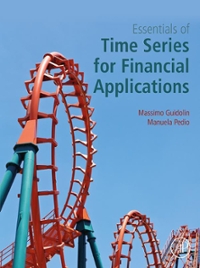Question
Question 1 You are a manager of a water supply company in Sydney. You have two plans for your customers as follows: Plan1: Bill=25+0.06L; and
Question 1
You are a manager of a water supply company in Sydney. You have two plans for your customers as follows:
Plan1: Bill=25+0.06L; and Plan2: Bill=40+0.04L;
Where, 'Bill' is the monthly bill in dollars and 'L' is the monthly total use of water in litres.
(a) Find the break-even level of total use of monthly water in litres.
(b) If your customer's average monthly use of water is 500 litres, advise which plan would be suitable for your customer?
(c) If your customer's average monthly use of water is 900 litres, advise which plan would be suitable for this customer?
(d) If there is a $10 reduction in the monthly fixed fee in Plan 2, then what would be your advice to the customer whose average monthly water use is 500 litres?
Question 2
The demand for Laptops in a certain country is given by D = 20000 - 100P; where P is the price of a laptop. Supply by domestic laptop producers is S = 12000 + 100P.
(a) Assuming that the economy is closed, find the equilibrium price and production quantity of laptops.
(b) The economy opens to trade. The world price of a laptop is $30. Find the domestic quantities demanded and supplied and the quantity of imports or exports. Who will support the opening of the laptop market to trade and who will oppose it?
(c) The government imposes a tariff of $4 per laptop. Find the effects on domestic quantities demanded and supplied and on the quantity of imports or exports. Also find the tariff revenue collected by government. Who will support the imposition of tariff and who will oppose it?
(d) Suppose the government imposes an import quota of 1200 laptops. Find the equilibrium price in the domestic laptop market, as well as the quantities produced by domestic firms and purchased by domestic consumers.
Question 3:
a) Price of a computer in Sydney is AU$1000, and the price of the similar computer in China is 5000 yuan. Under purchasing power parity theory (PPP), calculate the nominal exchange rate between Australian dollar and Chinese yuan.
b) Suppose this year Australia experiences inflation and the price of the computer increased to $1200. Calculate the new exchange rate and comment whether Australian dollar has appreciated or depreciated.
c) A British made automobile is priced at 20,000 (20,000 British pounds). A comparable U.S.-made car costs $26,000. One pound trades for US$1.50 in the foreign exchange market. Find the real exchange rate from the perspective of the US and from the perspective of Great Britain. Which country's cars are more competitively priced?
Question 4
An economy is described by the following equations:
C = 15000+0.5(Y-T) - 40000r, Ip=8000-20000r,
G=7000,
X= 0,
M=1800, T=T=8000, Y*= 40000
- a)Find a numerical equation relating planned aggregate expenditure to output and to the real interest rate (Given PAE=C+Ip+G+NX)
- b)What the Reserve Bank should set the real interest rate to eliminate output gap if any?
Question 5
An economy is described by the following equations: C = 4000 + 0.6 (Y - T)
Ip= 1500
G = 2000
NX = 200 T = 2000 Y* = 17000
a. For the economy, find the following: autonomous expenditure, the multiplier, short- run equilibrium output, and the output gap if any.
b. Illustrate this economy's short-run equilibrium on a Keynesian-cross diagram.
c. Calculate the amount by which autonomous expenditure would have to change to eliminate the output gap if any.
d. Suppose that the government decided to close the output gap by changing taxes. By how much must taxes be increased or decreased in order to eliminate the output gap if any?
Step by Step Solution
There are 3 Steps involved in it
Step: 1

Get Instant Access to Expert-Tailored Solutions
See step-by-step solutions with expert insights and AI powered tools for academic success
Step: 2

Step: 3

Ace Your Homework with AI
Get the answers you need in no time with our AI-driven, step-by-step assistance
Get Started


